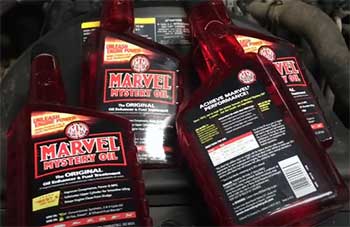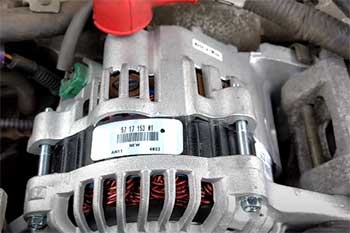I’ve spent years tinkering with engines—cars, trucks, motorcycles, even lawnmowers—and I’ve learned one thing: keeping them clean and running smoothly is a battle.
Fuel system cleaners like Super Tech Motor Treatment and Sea Foam promise to help, but which one actually delivers? In this article, I’m putting these two popular products head-to-head, sharing my experiences, analyzing their features, and breaking down their pros and cons.
My goal is to help you decide which is worth your money for keeping your engine in top shape.
A Brief Comparison Table
| Feature/Product | Super Tech Motor Treatment | Sea Foam Motor Treatment |
| Price (16 oz) | ~$4.83 (Walmart) | ~$6.74-$12 (varies by retailer) |
| Main Ingredients | Not fully disclosed (likely naphtha, solvents) | Naphtha, isopropanol, pale oil |
| Primary Uses | Fuel system cleaner, lubricant, stabilizer | Fuel system cleaner, lubricant, stabilizer |
| Application | Gas, diesel, oil, vacuum lines | Gas, diesel, oil, vacuum lines, intake |
| Effectiveness | Good for mild cleaning, budget-friendly | Proven for heavy carbon buildup, versatile |
| Fuel Stabilization | Up to 1 year | Up to 2 years |
| Engine Types | Gas, diesel, hybrid | Gas, diesel, 2-stroke, 4-stroke, GDI |
| Smoke During Use | Moderate | Heavy (especially via vacuum line) |
| Availability | Walmart (in-store, online) | Widely available (auto stores, online) |
| User Feedback | Positive for price, mixed on heavy cleaning | Highly rated, strong for high-mileage engines |
My Journey With Engine Additives
Let me take you back to my first encounter with engine additives. My old 2001 Chevy Silverado was chugging along, but it started idling rough, like it was coughing up a lung.
A mechanic friend suggested Sea Foam, and I was skeptical—pouring a liquid into my gas tank to “fix” things sounded like something out of a late-night infomercial. But I gave it a shot, and the difference was noticeable: smoother idle, better throttle response.
That got me hooked on additives, and over the years, I’ve tried everything from big-name brands to store generics like Super Tech. Each has its quirks, and I’ve learned what works (and what doesn’t) through trial and error.
Super Tech Motor Treatment and Sea Foam are two products I’ve used extensively, and they’re often compared because they’re both affordable, widely available, and claim to do similar things: clean fuel systems, lubricate engines, and stabilize fuel.
But they’re not identical twins—more like cousins with different personalities. Let’s break down what each brings to the table, starting with their core features.
What Is Super Tech Motor Treatment?
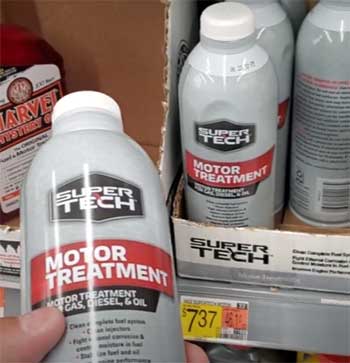
Super Tech Motor Treatment is Walmart’s house brand answer to engine additives.
Priced around $4.83 for a 16-ounce bottle, it’s a budget-friendly option that sits on the shelf next to pricier competitors like Sea Foam.
It’s marketed as a universal treatment for gas, diesel, and oil systems, designed to clean fuel injectors, lubricate engine components, and stabilize fuel for up to a year.
The label boasts a blend of cleaning agents, antioxidants, and corrosion inhibitors, but Walmart doesn’t fully disclose the ingredients.
Based on user discussions and my own research, it likely contains naphtha and other solvents, similar to many fuel treatments.
I first tried Super Tech in my 2007 Dodge Ram 1500, which I use for hauling. I poured an 8-ounce bottle into a half-full tank, drove it for a couple of days, and noticed a slight improvement in throttle response.
The engine felt a bit peppier, but nothing dramatic. I also used it in my lawnmower before winter storage, and it started up fine in the spring. For the price, it’s hard to complain, but I wondered if it could tackle tougher jobs like Sea Foam.
Key Features of Super Tech Motor Treatment
Let’s break down what Super Tech offers. I’ve used it in various vehicles, from my daily driver to my snowblower, so I’ve got a good sense of its strengths.
- Fuel System Cleaning: Super Tech claims to clean fuel injectors, carburetors, and combustion chambers. In my experience, it works well for light maintenance, like keeping injectors clear in newer vehicles. I used it in my 2018 Honda CR-V, and it seemed to maintain smooth performance, though I didn’t notice a huge difference since the car was already in good shape.
- Lubrication: It lubricates upper engine components, reducing wear. I added it to the crankcase of my old Yamaha motorcycle, and the engine sounded a bit quieter, but I wouldn’t call it transformative.
- Fuel Stabilization: Super Tech stabilizes fuel for up to a year, which is handy for seasonal equipment. My snowblower sat for six months with treated fuel and fired up without issue.
- Versatility: It’s safe for gas, diesel, and hybrid engines, making it a one-size-fits-all option. I’ve used it in both my truck and my wife’s hybrid with no problems.
- Affordability: At under $5, it’s one of the cheapest additives out there. For budget-conscious folks like me, that’s a big draw.
Pros of Super Tech Motor Treatment
I’ve found Super Tech to be a solid choice for specific scenarios. Here’s what I like about it.
- Cost-Effective: At roughly half the price of Sea Foam, it’s a steal. I can treat multiple vehicles without breaking the bank.
- Good for Maintenance: It’s great for newer engines or light cleaning tasks. My CR-V runs smoothly with regular use, and I don’t need to spend extra on a premium brand.
- Easy to Find: Available at Walmart stores and online, it’s convenient. I’ve grabbed a bottle during a late-night oil change run more times than I can count.
- Low Risk: It’s safe for most engines, and I’ve never had issues with it damaging components. It’s a low-stakes way to try an additive.
- Decent Performance: For mild carbon buildup or fuel system maintenance, it gets the job done. My lawnmower and snowblower have benefited from it during storage.
Cons of Super Tech Motor Treatment
Super Tech isn’t perfect, and I’ve run into some limitations.
- Limited Cleaning Power: It struggles with heavy carbon deposits. When I tried it in my high-mileage Explorer, it didn’t make a dent in the rough idle, unlike Sea Foam.
- Opaque Ingredients: Walmart doesn’t publish a full ingredient list, which makes me wary. I like knowing exactly what I’m putting in my engine.
- Shorter Stabilization: One year of fuel stabilization is fine but falls short of Sea Foam’s two-year claim. For long-term storage, I’d lean toward Sea Foam.
- Mixed Reviews: Some users, including myself, find it less effective for older engines. Online forums like BobIsTheOilGuy note it’s better for maintenance than deep cleaning.
- Brand Perception: As a Walmart house brand, it lacks the trust factor of established names like Sea Foam. I sometimes wonder if I’m getting a “generic” version.
What Is Sea Foam Motor Treatment?
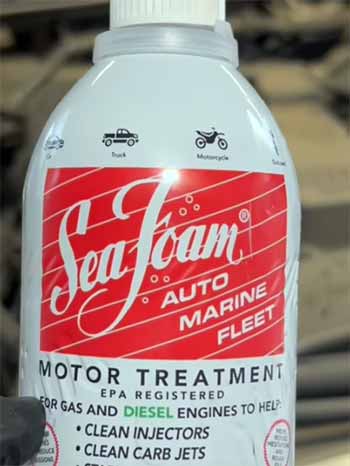
Sea Foam, around since the 1940s, is practically a legend in the automotive world.
Created by Fred Fandrei to keep his outboard motors running smoothly, it’s now a go-to for mechanics and DIYers alike.
A 16-ounce can costs $6.74 to $12, depending on where you buy it.
Its main ingredients—naphtha, isopropanol, and pale oil—are designed to clean fuel systems, dissolve carbon deposits, and stabilize fuel for up to two years.
It’s versatile, working in gas, diesel, and two-stroke engines, and can be used in fuel tanks, crankcases, or vacuum lines for a deep clean.
My first time using Sea Foam was a spectacle.
I followed the vacuum line method on my Silverado, slowly sucking the liquid into the intake while the engine ran at 2,000 RPM.
The cloud of white smoke pouring out of the exhaust had my neighbors thinking I was signaling for help. But after a 15-minute “hot soak” and a spirited drive, the engine ran smoother than it had in years. Sea Foam’s reputation for tackling carbon buildup is well-earned, but it’s not without its quirks.
Key Features of Sea Foam Motor Treatment
Sea Foam’s feature set is broader and more robust, which is why it’s a favorite among mechanics. Here’s what I’ve observed from using it across multiple vehicles.
- Deep Cleaning: Sea Foam excels at dissolving heavy carbon deposits. When I used it in my 1999 Ford Explorer with 200,000 miles, it reduced valve noise and improved idle stability. The vacuum line method is particularly effective for older engines.
- Fuel Stabilization: It keeps fuel fresh for up to two years, outlasting Super Tech. I used it in my boat’s outboard motor, and after a year of storage, it started on the first pull.
- Versatility: Sea Foam works in gas, diesel, two-stroke, and four-stroke engines, including GDI (Gasoline Direct Injection) systems. I’ve used it in everything from my lawnmower to my diesel tractor with consistent results.
- Lubrication: It lubricates fuel systems and crankcase components. In my Silverado, adding Sea Foam to the oil before a change seemed to quiet lifter noise temporarily.
- Proven Track Record: With decades of use and thousands of positive reviews (4.8/5 on Amazon with over 15,000 ratings), Sea Foam has a loyal following. My mechanic swears by it for high-mileage vehicles.
Pros of Sea Foam Motor Treatment
Sea Foam’s reputation is built on results, and I’ve seen why it’s so popular.
- Powerful Cleaning: It’s a beast at removing carbon buildup. My Silverado’s idle went from shaky to silky after a vacuum line treatment.
- Long Fuel Stabilization: Two years of fuel stability is a game-changer for seasonal equipment. My boat and motorcycle have benefited from this.
- Versatile Application: You can use it in fuel, oil, or vacuum lines. I’ve tried all three methods, and each delivers noticeable results.
- Trusted Brand: With 80 years of history and glowing reviews, Sea Foam feels like a safe bet. Mechanics I know recommend it without hesitation.
- GDI Compatibility: It’s designed for modern GDI engines, which is great for newer cars like my wife’s 2020 Toyota RAV4.
Cons of Sea Foam Motor Treatment
Sea Foam isn’t flawless, and I’ve hit some snags.
- Pricey: At $6.74-$12, it’s significantly more expensive than Super Tech. For frequent use, the cost adds up.
- Heavy Smoke: The vacuum line method produces a lot of smoke, which can be alarming. I once had a neighbor ask if my truck was on fire!
- Potential Risks: Overuse can thin oil or stress worn components. I learned this the hard way when I left it in my crankcase too long and noticed sludge in the oil.
- Not a Cure-All: It won’t fix mechanical issues. My friend tried it on a misfiring engine, and it didn’t help because the problem was a bad spark plug.
- Complex Application: The vacuum line method requires some know-how. I fumbled my first attempt and wasted half a can.
My Experiences With Sea Foam And Super Tech Motor Treatment
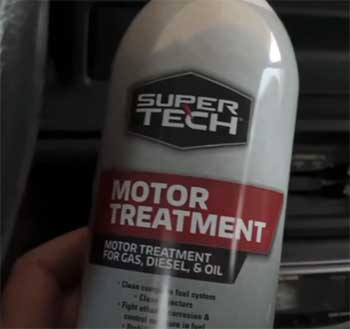
To give you a clearer picture, let’s talk about my hands-on tests.
I used Super Tech and Sea Foam in two vehicles: my 2007 Dodge Ram 1500 (150,000 miles) and my 2018 Honda CR-V (40,000 miles).
For the Ram, I wanted to tackle a rough idle and sluggish acceleration, likely from carbon buildup.
For the CR-V, I was focused on maintenance to keep it running smoothly.
In the Ram, I started with Super Tech, adding 8 ounces to a half-full tank.
After 100 miles, the idle was slightly smoother, but the sluggishness persisted. Next, I tried Sea Foam using the vacuum line method.
The smoke show was intense, but after a 20-minute drive, the idle was noticeably steadier, and throttle response improved. Sea Foam clearly outperformed Super Tech for deep cleaning.
For the CR-V, I used Super Tech as a maintenance dose (1 ounce per gallon) every 3,000 miles. It kept the engine running well, with no complaints. I also tried Sea Foam in the fuel tank at the same interval, and the results were comparable—smooth performance, no major changes.
Here, Super Tech held its own because the engine didn’t need heavy cleaning.
When To Choose Super Tech Motor Treatment?
Super Tech is my go-to when I’m on a budget or dealing with newer engines. If you’re maintaining a vehicle with under 100,000 miles, it’s a cost-effective way to keep things clean.
It’s also great for seasonal equipment like lawnmowers or snowblowers, where fuel stabilization is key. If you’re new to additives and don’t want to spend a lot, Super Tech is a low-risk starting point. I’d recommend it for:
- Newer vehicles with minimal carbon buildup.
- Budget-conscious users who want basic maintenance.
- Seasonal equipment needing fuel stabilization for up to a year.
When To Choose Sea Foam Motor Treatment?
Sea Foam is my pick for older, high-mileage vehicles or engines with serious carbon issues. If your car is idling rough, losing power, or burning oil, Sea Foam’s deep-cleaning power is worth the extra cost. It’s also ideal for long-term fuel storage or GDI engines. I’d recommend it for:
- High-mileage vehicles (over 100,000 miles) with carbon buildup.
- Boats, motorcycles, or equipment stored for long periods.
- Users comfortable with advanced application methods like vacuum line cleaning.
Comparing Application Methods
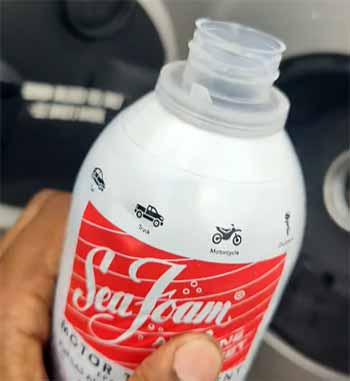
Both products can be used in fuel tanks, crankcases, or vacuum lines, but the experience differs.
Adding either to the fuel tank is simple: pour in 1-2 ounces per gallon and drive. I’ve done this with both, and it’s foolproof.
Crankcase use is trickier—add 1 ounce per quart of oil, run the engine briefly, then change the oil.
Sea Foam’s instructions are clearer here, and I’ve had better results with it in the crankcase.
The vacuum line method is where Sea Foam shines but also intimidates.
You need to find a vacuum line, slowly feed the product into the intake, and brace for smoke.
Super Tech can be used this way, but I found it less effective, producing less smoke and milder results. If you’re not mechanically inclined, stick to the fuel tank method for either.
Also Read: Is Sea Foam Motor Treatment Worth It?
Frequently Asked Questions (FAQ)
For fuel system cleaning, products with polyetheramine (PEA), like Chevron Techron or Gumout All-In-One, often outperform Sea Foam for injector cleaning. However, Sea Foam’s versatility across fuel, oil, and intake systems makes it unique.
Walmart doesn’t disclose the manufacturer, but some speculate CRC Industries produces it, based on user reviews. The exact maker remains unconfirmed.
It cleans fuel injectors, carburetors, and combustion chambers, lubricates engine components, and stabilizes fuel for up to a year, improving performance and preventing corrosion.
Sea Foam can be expensive, produce heavy smoke during vacuum line use, thin oil if overused, and may not fix mechanical issues. Overuse can also stress worn engine components.
Conclusion: Your Engine, Your Choice
You’ve got a vehicle that needs some love, and both Super Tech Motor Treatment and Sea Foam can help. I’ve shared my experiences to show you what each can do—Super Tech’s a wallet-friendly pick for keeping things tidy, while Sea Foam’s the heavy hitter for stubborn carbon or long-term storage.
Weigh your engine’s needs, your budget, and how much elbow grease you’re willing to put in. Whichever you choose, you’re taking a step toward a smoother-running ride. Let me know if you try one out—I’d love to hear how it goes for you!
